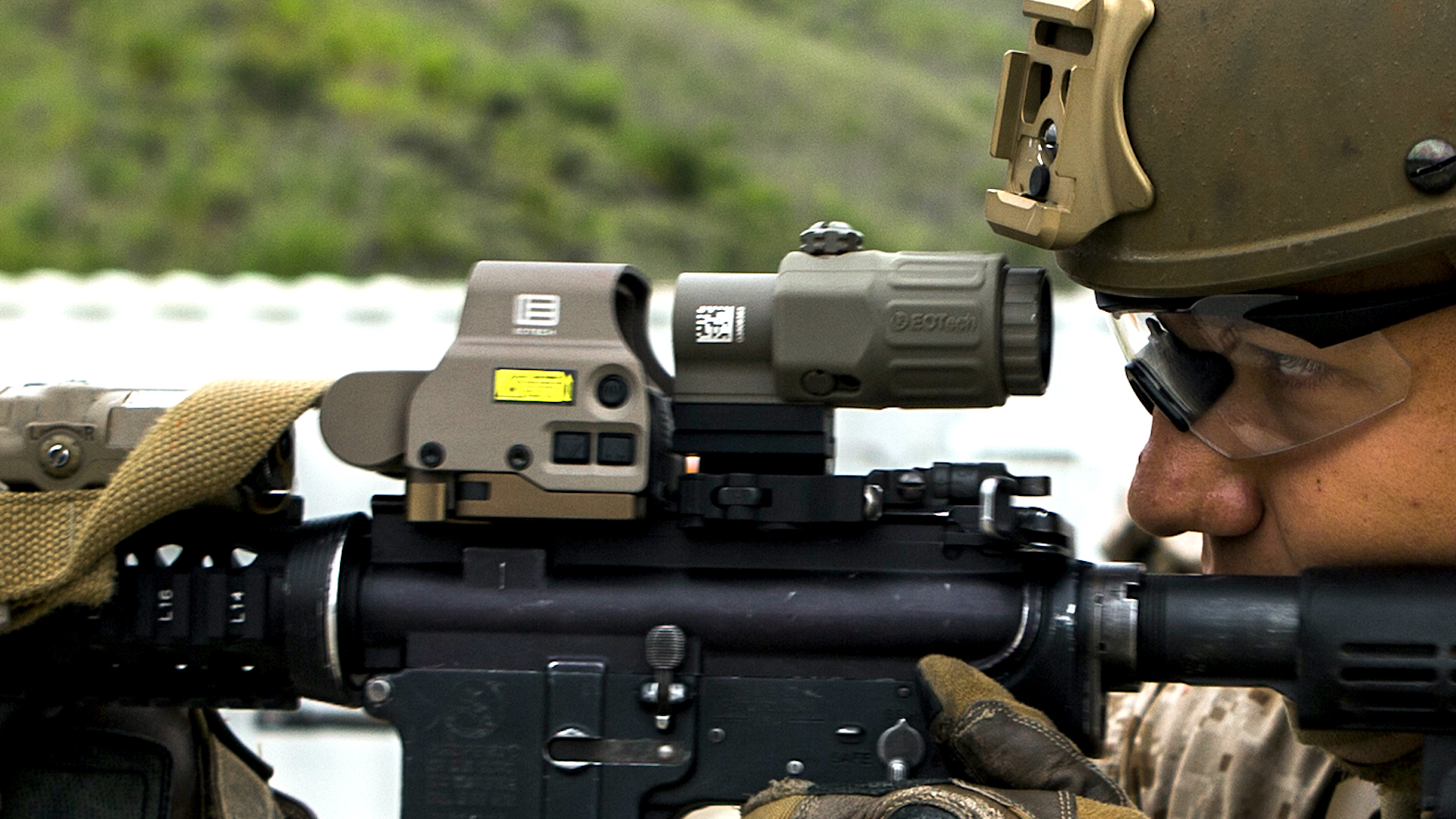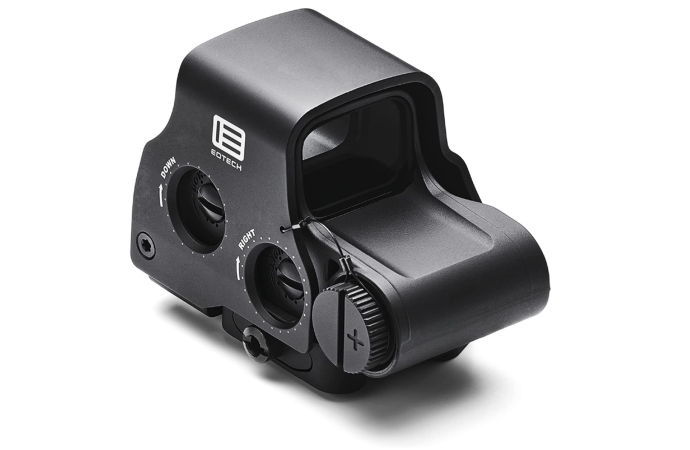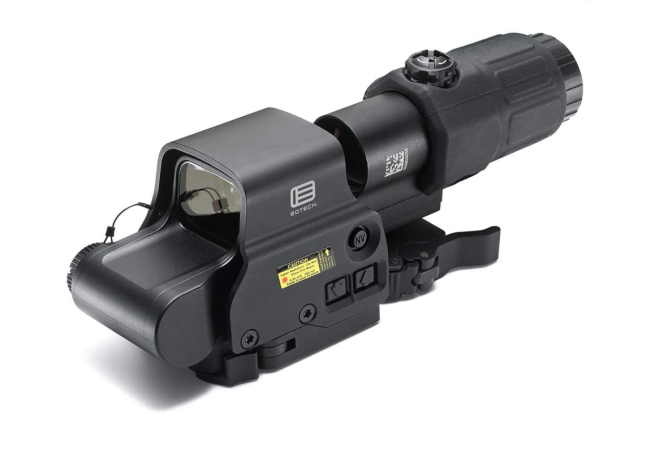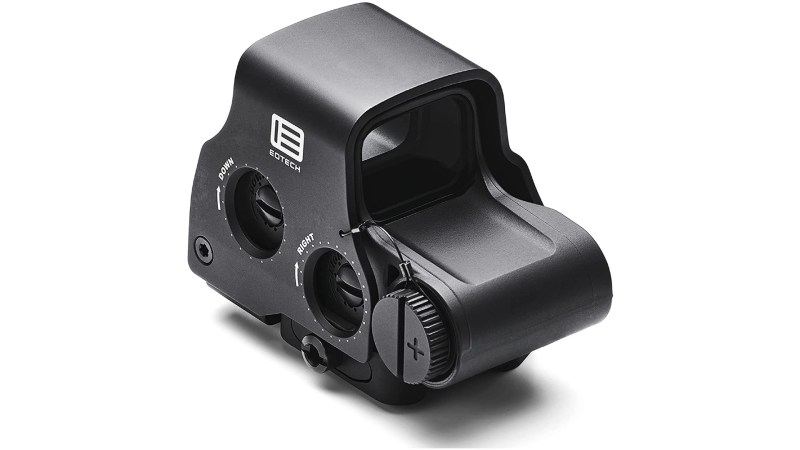We may earn revenue from the products available on this page and participate in affiliate programs.

Holographic sights are a unique type of gunsight that uses lasers to create a reticle that appears to “float” in front of the weapon in your field of view. They work by illuminating a reticle image stored on holographic film within the window, creating a precise image. By creating a reconstructed image rather than simply projecting a LED dot or crosshair onto a pane of glass, they ensure that the image is unaffected by things like astigmatism, magnification, and even a cracked objective lens. The sight adjusts for windage and elevation by tilting the holographic grating, and the brightness is adjusted by raising or lowering the intensity of the laser.
Since 1995, EoTech has remained the premier name in holographic sights, producing optics that some of the best shooters in law enforcement and the military rely on. The Michigan-based company’s first military optics were formally adopted in 2005 in the form of their 5x series of holographic weapons sights. This family of sights used batteries mounted parallel to the weapon’s barrel and featured controls on the rear of the optic; however, recoil had a tendency to knock these batteries loose, resulting in various issues. This led to the development of the XPS model, which solved this problem by replacing the parallel batteries with transverse-mounted CR123 batteries in a tube-shaped battery compartment, all but eliminating the risk of the recoil knocking the batteries loose.
All of EoTech’s decades of work on holographic sights has finally culminated with the EXPS model — namely, the EXPS 3 family of sights, which has a number of features that set it above not just previous EoTech models, but every other holographic sight on the market, making it one of the best choices for the serious shooter.
The EXPS 3 comes in three different variations and two different colors and can have its capabilities extended out to long ranges with the addition of a magnifier. These three variants feature different reticles, each featuring a different bullet-drop compensator, adjusted for 62 Grain 5.56×45 ammunition fired at 2,900 feet per second. The EXPS 3-0 simply features a hashed “speed ring” with a 1 minute-of-angle (MOA) dot, ideal for close-quarter engagements. The EXPS 3-2 features the same ring around 2 1 MOA dots, one meant for 50-200 yards, and the other, lower one meant for 500-yard engagements, allowing more precise range estimation for longer shots, without an overly-cluttered reticle. The EXPS 3-4 features four dots inside the speed ring, each graduated for 50-200, 400, 500, and 600, respectively. In addition, all EXPS3 variants are capable of being used when viewed through night vision, with a dedicated switch to engage night vision mode allowing a transition that’s as easy as flipping down your night vision devices and pressing the button.
With all this in mind, here’s what you should know when selecting your very own holographic sight — and why, undoubtedly, it should be some variant of the EoTech EXPS 3.
Best Holographic Sight Overall
EoTech EXPS 3-2 Holographic Weapons Sight
Best Long Range Holographic Sight
EoTech Hybrid Holographic Sight
Editor’s Choice
EoTech EXPS 3-0 Holographic Weapon Sight
FAQs on holographic sights
You’ve got questions, Task & Purpose has answers.
Q: Are holographic sights better than red dot?
A: Holographic sights have distinct advantages and disadvantages when compared to conventional red dots. While they suffer less from things like parallax, astigmatism distortion, and reticle scaling under magnification, they also have lower battery lives, are usually larger, and are almost always more expensive. What works will vary from shooter to shooter, and we encourage anyone to try before they buy.
Q: Do holographic sights work with astigmatism?
A: Holographic sights are widely considered to be the best options to use for those with astigmatism, due to the fact that the reticle is a hologram and not a single projected point of light as with a red dot.
Q: Can you use a magnifier with a holographic sight?
A: Absolutely. Holographic sights are arguably the best place to use magnifiers, since they will not also increase the size of the reticle, therefore ensuring consistency between magnification levels.
Q: Does the U.S. military use magnifiers?
A: Yes. Here are some photos of an EOTech Holographic Hybrid Sight III in use by ANGLICO Marines back in May 2020.

Our gear section
Matt Sampson is a Task & Purpose commerce writer. An 0861 in the Marine Forces Reserve and a Virginia native, he worked in tactical gear retail in his past life and is an avid firearms enthusiast. The farthest the Marine Corps has sent him from home is California.


